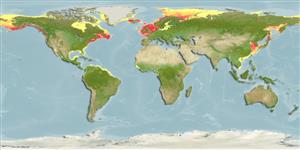Common names from other countries
Classification / Names / Names
Common names | Synonyms | Catalog of Fishes (gen., sp.) | ITIS | CoL | WoRMS
Environment: milieu / climate zone / depth range / distribution range
Ecology
Bathydemersal. Temperate; 90°N - 0°S, 180°W - 180°E
Atlantic Ocean, Pacific Ocean, the Arctic and North America Inland Waters: Portugal, Iceland, Greenland, Canada Newfoundland, Spain, France, Belgium, Ireland, Netherlands, Germany, Denmark, Norway, Sweden Lithuania, Poland, Latvia, Estonia, Finland, Russia, UK, USA, Canada, Mexico, Alaska, Japan, Kamchatka (Ref. 1394), Br Scotland, Madeira, British Columbia, Kuril Island, Sea of Okhotsk, Gulf of California, Baltic Sea, Barents Sea, Hudson Bay (Ref. 1522); Phoca vitulina vitulina: Portugal, UK, Iceland, Greenland, Br Scotland, Norway, Madeira, Baltic Sea, Barents Sea; Phoca vitulina concolor: Canada, Hudson Bay, USA, Greenland, Iceland; Phoca vitulina richardii: Mexico, Alaska, British Columbia, USA, Gulf of California; Phoca vitulina stejnegeri: Japan, Kamchatka, Alaska, Sea of Okhotsk, Kuril Island; Phoca vitulina mellonae: Hudson Bay, James Bay. Temperate to polar regions.
Length at first maturity / Size / Weight / Age
Maturity: Lm ? range ? - ? cm Max length : 190 cm TL male/unsexed; (Ref. 1394); 170 cm TL (female); max. published weight: 150.0 kg (Ref. 1394); max. published weight: 150.0 kg
Found in coastal waters of the continental shelf and slope (Ref. 1394); and whelp in groups on beaches, sandbars, and rocky reefs (Ref. 1522). Feeds on a wide variety of fish, cephalopods, and crustaceans of surface, mid-water and benthic habitats (Ref. 1394). It is preyed upon by the great white shark (Ref. 32140). Found in coastal waters of the continental shelf and slope (Ref. 1394); and whelp in groups on beaches, sandbars, and rocky reefs (Ref. 1522). Also for resting, moulting and lactation during low tides. Typically perform U-shaped dives. Leave the coast on foraging trips to deeper offshore waters where prey is abundant (Ref. 96347). Feeds on a wide variety of fish, cephalopods, and crustaceans of surface, mid-water and benthic habitats (Ref. 1394).
Jefferson, T.A., S. Leatherwood and M.A. Webber. 1993. (Ref. 1394)
IUCN Red List Status (Ref. 130435)
CITES status (Ref. 108899)
Not Evaluated
Human uses
Fisheries: commercial
FAO - Fisheries: landings, species profile | FishSource | Sea Around Us
Tools
Internet sources
Estimates based on models
Preferred temperature
(Ref.
115969): 3.4 - 11.2, mean 8.7 (based on 1375 cells).
Resilience
Medium, minimum population doubling time 1.4 - 4.4 years (K=0.09-0.4).
Vulnerability
High vulnerability (60 of 100).
Price category
Unknown.
